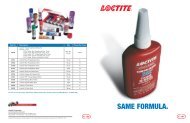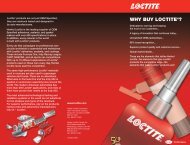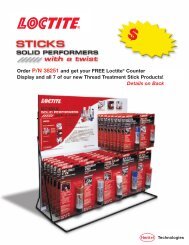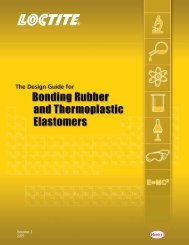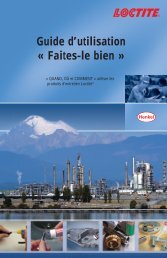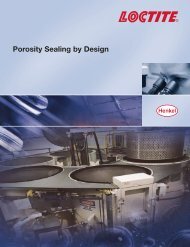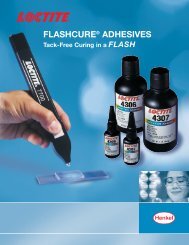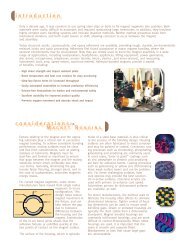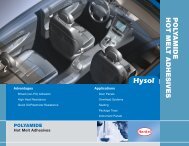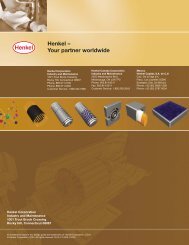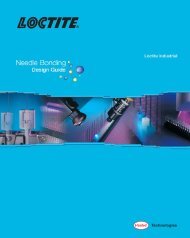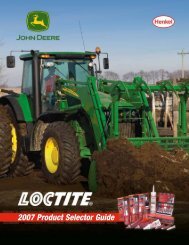Polycarbonate (PC)ThermoplasticTrade Names• Calibre• Karlex• Lexan• Makrolon• Novarex• Panlite• SinvetManufacturerDow ChemicalFerro CorporationGeneral ElectricMiles Inc.Mitsubishi ChemicalTeijin Chem Ltd.Enichem ElastomersGeneral DescriptionIn the polycarbonate resin, carbonate groups are used to link groups ofdihydric or polyhydric <strong>ph</strong>enols. General-purpose polycarbonate isformed by reacting bis<strong>ph</strong>enol A with <strong>ph</strong>osgene, but formulations usingother polyhydric <strong>ph</strong>enols are available. These include specialty resinswhich meet industry codes for flame retardance and smoke density,and resins with increased melt strength for extrusion and blow molding.Polycarbonate is a versatile and popular blend material for polyesterand ABS, and is widely used in the medical device industry as areplacement for glass. Additives and coatings are commonly used andcan greatly improve creep resistance, mold shrinkage, tensile modulus,thermal stability, weatherability, and all strength characteristics ofstandard polycarbonate. In 2004, the price of PC ranged approximatelyfrom $2.00 to $5.00 per pound at truckload quantities.General PropertiesPolycarbonate offers a unique combination of outstanding clarity andhigh impact strength. In addition, it is very dimensionally stable andhas low flammability. These characteristics make polycarbonate wellsuited for light transmission applications, such as automotive tail lighthousings. Due to the low levels of monomers and catalysts used inprocessing polycarbonate, it is generally biocompatible and suited foruse in medical applications where device surfaces may come intocontact with blood or other bodily fluids. PC offers a limited resistanceto chemicals and is soluble in many organic solvents. Solvent weldingor adhesively joining parts makes PC prone to stress cracking. Thiscan be overcome by selecting an adhesive with a rapid curemechanism, an adhesive with a low tendency to induce stresscracking, and/or annealing the part prior to adhesive application.Typical Properties of Polycarbonate (PC)American EngineeringProcessing Temperature 500°F to 575°F 260°C to 302°CLinear Mold Shrinkage 0.003 to 0.007 in./in. 0.003 to 0.007 cm/cmMelting Point – –Density 70.5 to 80.5 lb./ft. 3 1.13 to 1.29 g/cm 3Tensile Strength, Yield 8.4 to 9.6 lb./in. 2 x 10 3 5.9 to 6.7 kg/cm 2 x 10 2Tensile Strength, Break 7.4 to 10.9 lb./in. 2 x 10 3 5.2 to 7.7 kg/cm 2 x 10 2Elongation, Break 97.0 to 136.0% 97.0 to 136.0%Tensile Modulus 3.1 to 3.5 lb./in. 2 x 10 5 2.2 to 2.5 kg/cm 2 x 10 4Flexural Strength, Yield 12.4 to 14.0 lb./in. 2 x 10 3 8.7 to 9.8 kg/cm 2 x 10 2Flexural Modulus 3.2 to 3.5 lb./in. 2 x 10 5 2.2 to 2.5 kg/cm 2 x 10 4Compressive Strength 9.9 to 11.1 lb./in. 2 x 10 3 7.0 to 7.8 kg/cm 2 x 10 2Izod Notched, R.T. 11.3 to 17.0 ft.-lb./in. 60.8 to 91.8 kg cm/cmHardness R120 - R125 Rockwell R120 - R125 RockwellThermal Conductivity 1.3 to 1.6 BTU-in./hr.-ft. 2 -°F 0.19 to 0.23 W/m-°KLinear ThermalExpansionDeflection Temperature@ 264 psiDeflection Temperature@ 66 psiContinuousService Temperature2.9 to 3.9 in./in.-°F x 10 -5 2.2 to 7.0 cm/cm-°C x10 -5Typical Applications• Packaging – Reusable bottles, frozen foods, large water bottles• Food Service – Beverage pitchers, mugs, food processor bowls,tableware, microwave cookware• Automotive – Lamp housings and lenses, parts,electrical components, instrument panels• Medical – Filter housings, tubing connectors,surgical staplers, eyewear• Miscellaneous – Bulletproofing, computer housings,aircraft interiorsSI200°F to 350°F 98°C to 177°C280°F to 350°F 138°C to 177°C240°F to 275°F 116°C to 135°CDielectric Strength 375 to 500 V/10 -3 in. 1.5 to 2.0 V/mm x 10 4Dielectric Constant@ 1 MHzDissipation Factor@ 1 MHzWater Absorption,24 hr.2.7 to 3.2 2.7 to 3.20.009 to 0.010 0.009 to 0.0100.1 to 0.3% 0.1 to 0.3%40The <strong>Loctite</strong> ® Design Guide for Bonding Plastics, <strong>Volume</strong> 4
ADHESIVE SHEAR STRENGTH(psi)(MPa)PolycarbonateUNFILLED RESIN4 rmsROUGHENED18 rmsANTIOXIDANT0.1% Irgafos 1680.1% Irgafos 1076UV STABILIZER0.4% Tinuvin 234FLAME RETARDANT2% BT-931% Antimony OxideIMPACT MODIFIER5% Paraloid EXL3607LUBRICANT0.3% Mold WizINT-33UDKGLASS FILLER23% Type 3090Glass FillerCOLORANT4% CPCO7327<strong>Loctite</strong> ® 380 Black Max ® Instant Adhesive,Rubber Toughened7505.2160011.07505.27505.213009.010006.913009.011507.9165011.4<strong>Loctite</strong> ® 401 Prism ® Instant Adhesive,Surface InsensitiveMEDICAL: <strong>Loctite</strong> ® 4011 Prism ®Instant Adhesive, Surface Insensitive385026.6450031.0385026.6385026.6>4100 3850>28.3 26.6385026.6385026.6385026.6<strong>Loctite</strong> ® 401 Prism ®<strong>Loctite</strong> ® 770 Prism ® PrimerMEDICAL: <strong>Loctite</strong> ® 4011 Prism ® /<strong>Loctite</strong> ® 7701 Prism ® Primer200013.8340023.5200013.8200013.8>3800 2000>26.2 13.8200013.86004.15003.5<strong>Loctite</strong> ® 414 Super Bonder ®Instant Adhesive, General Purpose160011.0395027.2395027.2160011.0>3400 >4500 3850>23.5 >31.0 26.6270018.8395027.2<strong>Loctite</strong> ® 330 Depend ® Adhesive,Two-Part No-Mix Acrylic11007.611007.65503.84503.13002.15003.511007.611007.611007.6<strong>Loctite</strong> ® 3105 Light Cure Adhesive,MEDICAL: <strong>Loctite</strong> ® 3311 Light Cure Adhesive370025.5455031.4370025.5370025.5370025.5370025.5370025.5485033.5370025.5<strong>Loctite</strong> ® 3340 Light Cure Adhesive,UV Cationic Epoxy8005.5Adhesive PerformanceCalibre 300-4 produced by Dow Chemical<strong>Loctite</strong> ® 4305 Flashcure ® Light Cure AdhesiveFLUORESCENT: <strong>Loctite</strong> ® 4307 Flashcure ®Light Cure Adhesive<strong>Loctite</strong> ® H3000 Speedbonder Structural Adhesive, General Purpose<strong>Loctite</strong> ® H4500 Speedbonder Structural Adhesive, Metal Bonder<strong>Loctite</strong> ® 3030 Adhesive, Polyolefin Bonder<strong>Loctite</strong> ® E-00CL Hysol ® Epoxy Adhesive,Low Odor<strong>Loctite</strong> ® E-90FL Hysol ® Epoxy Adhesive,Flexible<strong>Loctite</strong> ® E-30CL Hysol ® Epoxy Adhesive,Glass BonderMEDICAL: <strong>Loctite</strong> ® M-31CL Hysol ®Epoxy Adhesive, Glass Bonder<strong>Loctite</strong> ® E-20HP Hysol ® Epoxy Adhesive,Fast SettingMEDICAL: <strong>Loctite</strong> ® M-21HP Hysol ®Epoxy Adhesive, Fast Setting<strong>Loctite</strong> ® E-214HP Hysol ® Epoxy Adhesive,High Strength>4250 >29.3 12508.611007.68505.99006.211507.9265018.312008.312008.3<strong>Loctite</strong> ® 4305 Flashcure ® Light Cure Adhesive achieved bond strengths which were higher than the grade ofunfilled polycarbonate tested. <strong>Loctite</strong> ® 401 Prism ® and 414 Super Bonder ® Instant Adhesives, <strong>Loctite</strong> ®3105 Light Cure Adhesive, and <strong>Loctite</strong> ® E-30CL Hysol ® Epoxy Adhesive, <strong>Loctite</strong> ® 3631 Hysol ® Hot MeltAdhesive, and <strong>Loctite</strong> ® Fixmaster ® High Performance Epoxy all achieved the very high bond strengths on PC.<strong>Loctite</strong> ® 3651 and 7804 Hysol ® Hot Melt Adhesives achieved the lowest bond strengths.Surface TreatmentsSurface roughening either caused no effect or a statistically significant increase in the bondability of PC. Theuse of <strong>Loctite</strong> ® 770 Prism ® Primer in conjunction with <strong>Loctite</strong> ® 401 Prism ® Instant Adhesive, or <strong>Loctite</strong> ®4011 Prism ® Medical Device Instant Adhesive with <strong>Loctite</strong> ® 7701 Prism ® Primer, caused a statisticallysignificant decrease in the bond strengths achieved on PC for most of the formulations evaluated.Other Important Information• Polycarbonate is generally compatible with acrylic and cyanoacrylate adhesives, but thereis a potential for stress cracking. In addition, polycarbonate can be attacked by the activatorsfor two-part, no-mix acrylic adhesives before the adhesive has cured. Any excess activatorshould be removed from the surface of the polycarbonate immediately.<strong>Loctite</strong> ® Fixmaster ® High Performance Epoxy<strong>Loctite</strong> ® 1942 Hysol ® Hot Melt Adhesive,EVA Based245016.93502.4• Polycarbonate is incompatible with anaerobic adhesives.• Surface cleaners: isopropyl alcohol, <strong>Loctite</strong> ® ODC-Free Cleaner & Degreaser.<strong>Loctite</strong> ® 3651 Hysol ® Hot Melt Adhesive,Polyolefin1000.7<strong>Loctite</strong> ® 7804 Hysol ® Hot Melt Adhesive1000.7<strong>Loctite</strong> ® 3631 Hysol ® Hot Melt Adhesive,Urethane<strong>Loctite</strong> ® U-05FL Hysol ® Urethane Adhesive,High Strength<strong>Loctite</strong> ® Fixmaster ® Rapid Rubber RepairOEM: <strong>Loctite</strong> ® U-04FL Hysol ®Urethane Adhesive, Fast Setting<strong>Loctite</strong> ® 5900 ® Flange Sealant,Heavy Body RTV Silicone320022.18505.96004.12001.4NOTES: The force applied to the tests specimens exceededthe strength of the material resulting in substrate failurebefore the actual bond strength achieved by the adhesivecould be determined.The addition of the indicated additive (or surfaceroughening) caused a statistically significant decrease inthe bond strength within 95% confidence limits.The addition of the indicated additive (or surfaceroughening) caused a statistically significant increase inthe bond strength within 95% confidence limits.The <strong>Loctite</strong> ® Design Guide for Bonding Plastics, <strong>Volume</strong> 4 41



